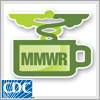A CUP OF HEALTH WITH CDC
Get Ticks Off
Tularemia in Humans — Missouri, 2000–2007
July 16, 2009
[Announcer] This podcast is presented by the Centers for Disease Control and Prevention. CDC — safer, healthier people.
[Dr. Gaynes] Welcome to A Cup of Health with CDC, a weekly feature of the MMWR, the Morbidity and Mortality Weekly Report. I’m your host, Dr. Robert Gaynes.
If your summer vacation plans include an excursion in the great outdoors, beware of a potential hazard. Ticks carry diseases such as tularemia and Lyme disease. The bite of an infected tick can result in serious illness and even death.
Dr. Ingrid Weber is an EIS officer with CDC’s Division of Vector-borne Infectious Diseases and she’s joining us by telephone today to discuss the diseases caused by tick bites. Welcome to the show, Ingrid.
[Dr. Weber] Thank you. Good to be speaking with you.
[Dr. Gaynes] Ingrid, what kinds of tick-borne illness occur in the U.S. and how many cases of these illnesses are there each year?
[Dr. Weber] Well, there a range of different tick-borne diseases, ranging from bacterial, viral, and parasitic diseases. And examples of these would be Lyme disease, Rocky Mountain Spotted Fever, Tularemia, Colorado Tick Fever, and Bobesiosis, among others. The numbers that we see are usually between 20,000 to 30,000 per year.
[Dr. Gaynes] Are cases more common during any particular season of the year?
[Dr. Weber] Yes, actually, there are and that depends largely on when ticks feed, and this varies from disease to disease, but for the most part, we see many of the cases in the late spring and during the summer months.
[Dr. Gaynes] Do certain regions of the country have higher rates of disease caused by ticks?
[Dr. Weber] Yes and again, this would depend on the disease and where the tick vectors are present. So, for example, in Lyme disease, we see three areas of the country in which cases occur and that’s usually in the northeast, in the midwest, and in northern California. Whereas, for example, in Rocky Mountain Spotted Fever, although cases can occur in a number of places in the country, over recent years, those occur more commonly in the southeast and southern regions of the U.S.
[Dr. Gaynes] Ingrid, what are the most common symptoms of at least the two illnesses your branch focuses on, Lyme disease and Tularemia?
[Dr. Weber] Well, in Lyme disease, most commonly, the symptom that we see is an expanding circular rash within about a month of the infection, and some patients don’t develop a rash but if they are untreated, they may go on to develop symptoms, such as neurological symptoms or headaches or neck stiffness, as well as certain cardiovascular symptoms, like faintness or light headedness and then also joint pains moving from joint to joint.
In Tularemia, we tend to see most commonly that there’s a ultra-glandular type of disease. In other words, where the tick bite occurs then also forms there and then the closest lymph nodes or glands tend to swell up, and in some cases, it may just be the gland swelling up and really, there may be other symptoms of disease more systemic, like a pneumonia.
[Dr. Gaynes] Can household pets transmit these diseases to their owners?
[Dr. Weber] Well, for Lyme disease and Tularemia, the household pets do not serve as reservoirs, or sources, of infection for these diseases. But the pets may become infected themselves or they may carry infected ticks into the household environment. For that reason, it’s important to check animals for ticks and make sure that those are removed.
[Dr. Gaynes] Ingrid, what precautions can people take to avoid being bitten by a tick?
[Dr. Weber] Well, there are a number of things that people can do. The first thing would be to avoid areas where ticks occur commonly, so in wooded areas where there’s a lot of leaf litter. The second thing would be to apply insect repellent to the skin and we recommend using 20 to 30 percent of a repellent called D-E-E-T, DEET. And then the third thing would be to cover up with clothing, so tucking pants legs into socks, for example. The last thing and very importantly is to frequently do tick checks. So, in other words, checking parts of the body where ticks might occur and those may be on the lower extremities – the feet, the legs – but even higher up, as well, and especially in children, just to check on their heads, as well, and to remove those ticks promptly.
[Dr. Gaynes] Where can listeners get more information about tick-borne illness?
[Dr. Weber] Well, they could consult the CDC website and the particular URL for that is www.cdc.gov/ticks/diseases, and that provides a lot of information about the diseases themselves, as well as giving guidance on how to remove ticks.
[Dr. Gaynes] Thanks Ingrid. I’ve been talking today with CDC’s Dr. Ingrid Weber about illnesses caused by ticks.
Remember, if you’ve been bitten by a tick and are having flu-like symptoms, see your healthcare provider immediately.
Until next time, be well. This is Dr. Robert Gaynes for A Cup of Health with CDC.
[Announcer] For the most accurate health information, visit www.cdc.gov or call 1-800-CDC-INFO, 24/7.



